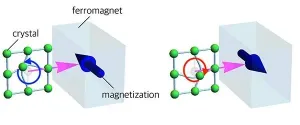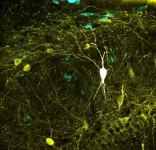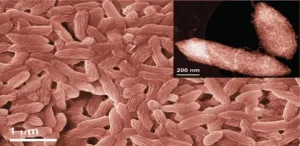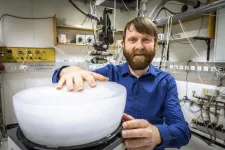(Press-News.org) Five years on from the first discovery of gravitational waves, an international team of scientists, including from the ARC Centre of Excellence for Gravitational Wave Discovery (OzGrav), are continuing the hunt for new discoveries and insights into the Universe. Using the super-sensitive, kilometre-sized LIGO detectors in the United States, and the Virgo detector in Europe, the team have witnessed the explosive collisions of black holes and neutron stars. Recent studies, however, have been looking for something quite different: the elusive signal from a solitary, rapidly-spinning neutron star.
Take a star similar in size to the Sun, squash it down to a ball about twenty kilometres across - roughly the distance from Melbourne airport to the city centre - and you'd get a neutron star: the densest object in the known Universe. Now set your neutron star spinning at hundreds of revolutions per second and listen carefully. If your neutron star isn't perfectly spherical, it will wobble about a bit, and you'll hear a faint "humming" sound. Scientists call this a continuous gravitational wave.
So far, these humming neutron stars have proved elusive. As OzGrav postdoctoral researcher Karl Wette from the Australian National University explains: "Imagine you're out in the Australian bush listening to the wildlife. The gravitational waves from black hole and neutron star collisions we've observed so far are like squawking cockatoos - loud and boisterous, they're pretty easy to spot! A continuous gravitational wave, however, is like the faint, constant buzz of a faraway bee, which is much more difficult to detect. So we've got to use a few different strategies. Sometimes we hone in on a particular direction ? for example, a flowering bush where bees are likely to congregate. Other times, we close our eyes and listen keenly to all the sounds we can hear, and try to pick out any buzzing sounds in the background. So far, we haven't had any luck, but we'll keep trying! Once we do hear a continuous gravitational wave, we'll be able to peer deep into the heart of a neutron star and unravel its mysteries, which is an exciting prospect."
A recent collaborative study with OzGrav has taken a closer look at the remnants of exploded stars, called supernovae. OzGrav PhD student Lucy Strang from the University of Melbourne explains: "Our search targets fifteen young supernova remnants containing young neutron stars. We use three different pipelines: one optimized for sensitivity, one that can handle a rapidly evolving signal, and one optimized for one likely astrophysical scenario. This is the first LIGO study covering all three of these scenarios, maximising our chance of a continuous wave detection. Continuous gravitational waves are proving very difficult to detect, but the same properties that make them elusive make them appealing targets. The exact form of the signal (i.e. its frequency, how rapidly the frequency changes, how loud it is, etc.) is dependent on what neutron stars are made of. So far, the structure of neutron stars is an open question that draws in all kinds of physicists. Even without a detection, a search allows us to peek behind the curtain at the unknown physics of neutron stars. When we do detect continuous waves, we'll open the curtain and shine a spotlight on new physics. Until then, we can use the information we do have to refine our understanding and improve our search methods."
OzGrav Associate Investigator Lilli Sun from the Australian National University says: "Young neutron stars in supernova remnants are promising targets to look for those tiny continuous gravitational waves, because they haven't spent a long enough time to relax and smooth out the asymmetries introduced at their birth. In our endeavor to search for continuous waves from these young neutron stars in our third observing run, we take into consideration, for the first time, the possibilities that the interior configuration and structure of the star can result in signals emitted at two different harmonics. Although no signal has been detected in O3, we set interesting constraints on the neutron star properties. If such a signal can be detected in future observations when the detectors are more sensitive, it will shed light on the fascinating structure of a neutron star."
OzGrav postdoctoral researcher Carl Blair from the University of Western Australia says: "Gravitational waves are being used to probe the most exotic objects in the Universe. Neutron stars - composed of matter collapsed in on itself like a giant atomic nuclei - have to be one of the most exotic. We don't know that much about neutron stars because they're so small and strange. Are they hard or soft? And when they spin fast as they collapse, do they wobble away that energy in the form of gravitational waves? While there is no evidence yet for continuous gravitational waves from neutron stars, limits have been placed on how wobbly a neutron star is from the fact that we haven't measured gravitational waves from them yet."
In addition, recent studies announced by the international research team - including the U.S./international LIGO Scientific Collaboration, European Virgo Collaboration and Japanese KAGRA Collaboration - have focussed on pulsars. These are neutron stars which act as cosmic lighthouses, beaming out copious energy in the form of radio waves. Pulsars are like giant spinning magnets, except they're billions of times stronger than the ones stuck to your fridge. So strong, in fact, that the magnetic field distorts the shape of the neutron star, and may lead to a tell-tale hum of continuous gravitational waves. While the recent studies did not pick up anything, they found tight constraints on how loud the "hum" could be, which, in some cases, are starting to challenge theoretical predictions.
OzGrav PhD student Deeksha Beniwal from the University of Adelaide says: "Gravitational-wave observation from O3 run of LIGO and Virgo detectors has allowed us to set realistic constraints on signals expected from young pulsars. O3 observations also provide an opportunity to test out different pipelines - such as different search methods for continuous wave signals ? in realistic environments."
OzGrav postdoctoral researcher Meg Millhouse from the University of Melbourne says: "Continuous gravitational waves from neutron stars are much smaller than the gravitational waves LIGO and Virgo have seen so far. This means we need different techniques to detect them. And, because these are long lasting signals, we need to look at lots of data which can be very difficult computationally. The recent LIGO-Virgo papers published showcase a wide range of these clever approaches to detect continuous gravitational waves. Even though there were no detections in the most recent data analysed, we're in a good position to keep searching and possibly make a detection when LIGO collects more data."
Scientists estimate that there are billions of neutron stars in the Milky Way with a faint murmur of continuous gravitational waves. Further studies have therefore taken an "ears wide open" approach, combing through the LIGO and Virgo data for any hint of a signal. The results so far suggest that these murmurings are extremely quiet and out of the detectors' "ear" range. However, as detector technology becomes more advanced and sensitive, the first ever detection of continuous gravitational waves could soon become a reality.
INFORMATION:
The hunt for the never before heard "hum" of gravitational waves caused by mysterious neutron stars has just got a lot easier, thanks to an international team of researchers.
Gravitational waves have only been detected from black holes and neutron stars colliding, major cosmic events that cause huge bursts that ripple through space and time.
The research team, involving scientists from the LIGO Scientific Collaboration (LSC), Virgo Collaboration and the Centre for Gravitational Astrophysics (CGA) at The Australian National University (ANU), are now turning their eagle eye to spinning neutron stars to detect the waves.
Unlike the massive bursts caused by black holes or neutron stars colliding, the researchers ...
AMHERST, Mass. - New research by University of Massachusetts Amherst astronomer Daniel Wang reveals, with unprecedented clarity, details of violent phenomena in the center of our galaxy. The images, published recently in Monthly Notices of the Royal Astronomical Society, document an X-ray thread, G0.17-0.41, which hints at a previously unknown interstellar mechanism that may govern the energy flow and potentially the evolution of the Milky Way.
"The galaxy is like an ecosystem," says Wang, a professor in UMass Amherst's astronomy department, whose findings are a result of more than two decades of research. "We know the centers of galaxies are where the action is and play an enormous role in their evolution." And yet, whatever has ...
Individuals with genetic high cholesterol, heart disease or both, who were infected with COVID-19 had more heart attacks according to new research by the FH Foundation. While previous studies have speculated about poorer outcomes if a person with genetic high cholesterol - called familial hypercholesterolemia (FH) contracts COVID-19, this study from the FH Foundation's national healthcare database is the first to demonstrate higher heart attack rates in the real world. Published online in the American Journal of Preventive Cardiology, the study also importantly confirms that COVID-19 increases heart attack rates in individuals with established atherosclerotic cardiovascular disease (ASCVD).
The FH Foundation performed an analysis of 55,412,462 individuals, separating groups into six ...
Leesburg, VA, May 27, 2021--According to an open-access Editor's Choice article in ARRS' American Journal of Roentgenology (AJR), accurate prenatal diagnosis of severe placental accreta spectrum (PAS) disorder by imaging could help guide maternal counseling and selection between hysterectomy and uterine-preserving surgery.
"The findings suggest strong performance of placental bulge in diagnosing severe PAS on both ultrasound and MRI, with potentially relatively stronger performance on MRI," wrote corresponding author Manjiri Dighe from the department of radiology at the University of Washington School of Medicine. "Nonetheless, interobserver agreement remains suboptimal on both modalities."
On ultrasound and MRI alike, the placental bulge sign represents ...
A small Japanese fishing community devastated by the Great East Japan Earthquake and Tsunami of 2011 managed to recover from the disaster through cooperative community activity despite the propensity for individualist-competitive behavior within fisheries - cooperative activity that continued many years later.
A social scientist who spent years interviewing fishers in the fishing hamlet of Isohama has discovered a long-standing continuum of competitive and collective endeavor amongst fishers, with potential ramifications for how government policy can better promote resilience in the wake of natural disasters and other calamities.
The findings appear in the journal of Disaster ...
Using the circular vibration of surface acoustic waves, a collaborative research group have successfully controlled the magnetization of a ferromagnetic thin film.
Their research was published in the journal Nature Communications on May 10, 2021.
Essentially, acoustic waves are waves of atomic vibrations in a substance. When the waves propagate across the surface of a material, the vibration becomes circular. This circular motion, known as angular momentum, can help measure rotational motion.
Surface acoustic waves are utilized in bandpass filters in cell phones. The bandpass allows certain frequencies ...
New Orleans, LA - A review study led by Maria D. Sanchez-Pino, PhD, an assistant research professor in the departments of Interdisciplinary Oncology and Genetics at LSU Health New Orleans' School of Medicine and Stanley S. Scott Cancer Center, advances knowledge about the connection between obesity-associated inflammation and cancer. The researchers suggest that inflammatory cells with immunosuppressive properties may act as a critical biological link between obesity and cancer risk, progression, and metastasis. The paper is published in the June 2021 issue of Obesity, available here.
Despite evidence showing that ...
The study, which is published in the journal PLOS Biology, represents the most comprehensive mapping performed to date between neural activity recoded in vivo and identified neuron types. This major breakthrough may enable biologically meaningful computer modeling of the full neuronal circuit of the hippocampus, a region of the brain involved in memory function.
Circuits of the mammalian cerebral cortex are made up of two types of neurons: excitatory neurons, which release a neurotransmitter called glutamate, and inhibitory neurons, which release GABA (gamma-aminobutanoic acid), the main inhibitor of the central nervous system. "A balanced dialogue between the 'excitatory' and 'inhibitory' activities is critical for brain function. ...
Exploiting the unusual metal-reducing ability of the iron-breathing bacterium Geobacter sulfurreducens, KAUST researchers have demonstrated a cheap and reliable way to synthesize highly active single-atom catalysts. The innovation, which could dramatically improve the efficiency and cost of hydrogen production from water, highlights the role nature can play in the search for new energy systems.
Many chemical reactions require a catalyst as a reactive surface where atoms or molecules are brought together with the right amount of energy to spark a chemical change. Water, for example, can be split into hydrogen and oxygen atoms by reacting on a pair of electrodes made of platinum and iridium oxide. The efficiency of the reaction, however, depends largely ...
Water freezes and turns to ice when brought in contact with a cold surface - a well-known fact. However, the exact process and its microscopic details remained elusive up to know. Anton Tamtögl from the Institute of Experimental Physics at TU Graz explains: "The first step in ice formation is called 'nucleation' and happens in an incredibly short length of time, a fraction of a billionth of a second, when highly mobile individual water molecules 'find each other' and coalesce." Conventional microscopes are far too slow to follow the motion of water molecules and so it is impossible to use them to 'watch' how molecules combine on top of solid surfaces.
Findings turn previous understanding of ice formation upside down
With the help ...







